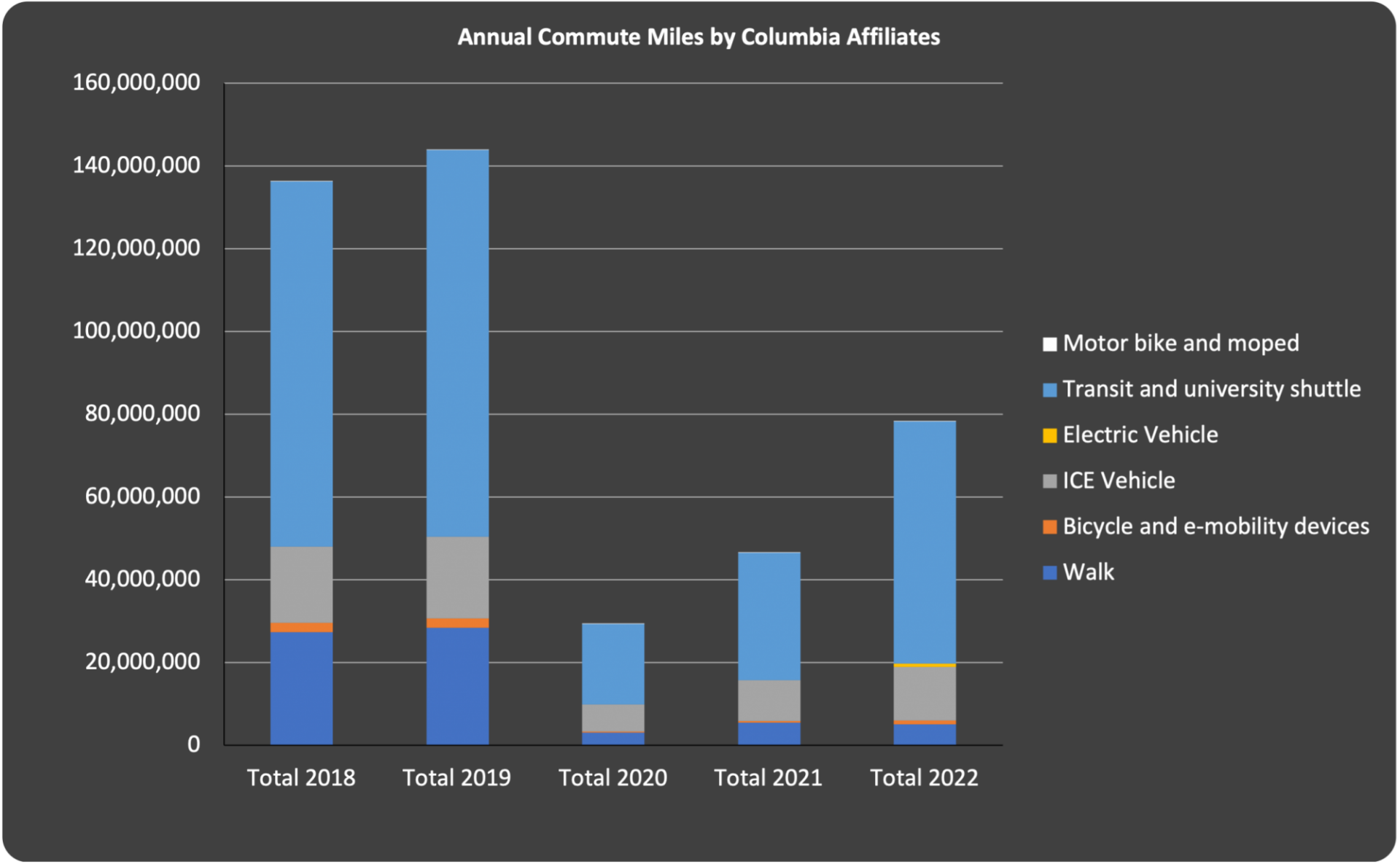Commute Travel by Columbia Affiliates has Increased to About Half of Pre-pandemic Levels
In the quest for a more sustainable Columbia, the Office of Sustainability has been tracking and reporting commute travel trends and related emissions since 2017. The University has since implemented initiatives that promote car-free travel alternatives to enhance campus accessibility and reduce emissions, parking, and traffic congestion associated with commuting. The COVID-19 pandemic greatly changed how many employees work, creating a co-benefit of reduced travel, which supported Columbia’s sustainability goals.
During the pandemic, Columbia’s learning and working operations went almost entirely online, bringing the University’s commute impact to near-zero. Almost overnight, students, staff, and faculty adapted to doing business and instruction virtually. Today, with instruction largely back to normal, commute travel has returned. However, many employees have since transitioned to a hybrid work schedule, resulting in fewer commuting emissions than pre-pandemic levels.
Prior to the pandemic, efforts to educate people about the sustainability benefits of flexible work arrangements existed. However, changing culture is gradual and difficult. In addition to needing approval from management, not all Columbia affiliates were enthusiastic about learning new video-conferencing technology. The immediacy of the pandemic catalyzed all Columbia affiliates — and much of the world — to simultaneously learn video-conferencing tools like Zoom within weeks. The unpredictable duration of the pandemic further cemented this new way of learning and working, and subsequently influenced our culture today. In many instances a return to campus was necessary, but many employees’ roles are digital and lend themselves to a hybrid work arrangement.
Working remotely leads to lower commute costs, time saved, and reduced stress from commuting. Many Columbia employees have chosen to adopt a hybrid work schedule meaning they’re not commuting to and from Columbia five days per week, but instead are now working two or three days per week at home. The University’s choice to allow department managers to decide on what positions can be done on a hybrid schedule has resulted in reduced travel overall and lower commute emissions compared to pre-pandemic levels, as well as reduced parking and traffic congestion from Columbia operations, all of which are goals outlined in Columbia’s Plan 2030.
Columbia’s Office of Sustainability tracks commute travel to and from the University through periodic surveys that are typically administered every two years. The data has been important for the University to report its greenhouse gas emissions as well as to direct University-led transportation initiatives, such as shuttle services, a park and ride service, and carpooling services, all outlined on Columbia’s Transportation website. Columbia’s commute survey is distributed University-wide via email and asks a series of questions, including one’s home ZIP Code, their primary campus location, and questions about what travel modes were used for their commute on a sample week. For the 2022 survey, affiliates were asked what modes of travel they used for the week of Monday April 4, 2022 through Sunday April 10, 2022, as well as to identify the days they were on campus, remote, on leave, sick, or not scheduled to be at work or class that day.
Columbia typically gets about a 20% response rate from its commute surveys. The data is used to calculate how many miles are traveled by each possible commute mode: walk, bike, car (electric and internal combustion engine), bus, train, University shuttle, motorbike, moped, and even some emerging options like e-scooters. The survey also takes into consideration people who use two or more modes in one commute; for example, someone who takes Metro North to Harlem, then takes the Columbia shuttle to the Manhattanville campus.
The total number of miles traveled by each mode for each survey respondent is calculated for one calendar year for each campus location. Then, the data is extrapolated by each campus's total population for both students and employees to represent the data as if the whole University responded. After that, both the student and employee data is combined to give the total miles traveled for each travel mode. The table below was created using this information and shows total commute miles traveled by University affiliates for each year, as well as how many miles were traveled by the various travel modes for each year.

The survey data shows that in 2019, Columbia affiliates traveled an estimated 144 million miles per year. In 2020, that dropped 80% to an estimated 29 million miles. Today, commute travel has returned to about half of pre-pandemic levels; in 2022 Columbia reported about 80 million commute miles.
Given the drastic changes over the past few years, below are some high-level commute statistics derived from Columbia’s commute survey:
- Commute travel has gradually returned year over year since the pandemic but is still down for all modes, with the total annual miles traveled for 2022 down 44% compared to 2019
- Annual miles traveled by internal combustion engine (ICE) car in 2022 is down 34% from 2019
- Since the rebound in travel after 2020, travel by transit and University shuttle has rebounded the strongest, up 208%, followed by travel by bike and e-mobility devices which has rebounded 191%. Travel by walking and car (ICE) have been the weakest to rebound at 66% and 100% respectively.
The data shows increased use of more sustainable modes of transportation, particularly bicycles and e-mobility devices. Travel by car decreased the least during the pandemic, but has been the second slowest to return of all modes. Travel by walking has experienced the largest decrease and is the slowest to return. Of note, 2022 was the first time Columbia began tracking miles traveled by electric vehicles, adding a new dimension to our sustainability tracking initiatives.
As part of Columbia’s sustainability efforts to reduce emissions as well as parking and traffic congestion associated with University operations, Columbia has put in place a robust set of transportation demand management (TDM) initiatives. These TDM initiatives include a comprehensive shuttle network that connects Columbia’s campuses and key transit hubs, including areas lacking public transit options like Fort Lee, NJ and Lamont Doherty Earth Observatory in Palisades, NY (where Columbia also offers a park and ride option). Other TDM initiatives include carpool matching, guaranteed ride home services, and bicycle amenities, all of which are listed on Columbia’s Transportation webpage. In addition to offering travel services, Columbia has maintained and grown its presence in an urban environment with plenty of near-to-campus housing with excellent access to rapid transit, resulting in a very low-impact commute when compared to many other American universities of its size. Columbia will continue to track and report its travel impacts and emissions and seek out ways to improve access to campus by sustainable, car-free travel modes that support the goals outlined in Plan 2030.
